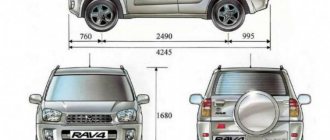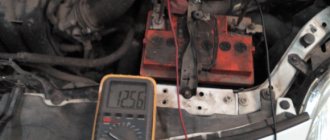Due to the fact that the technical characteristics of the Toyota RAV4 are very attractive to potential owners, the demand for the car is always high. This is largely due to the versatility, durability, practicality and high comfort of this vehicle. The SUV received its name RAV4 as a result of the abbreviation of the full name - Recreation Active Vеhicle 4.
Technical characteristics of the first generation of cars (1994-2000)
The first version of the RAV 4, which was introduced in 1994, was a three-door short crossover with an original sporty design. Externally, it resembled an off-road coupe. The dimensions of the car at that time were 3705 mm in length, 1695 mm in width, 1650 mm in height. Ground clearance - 200 mm.
Main crossover parameters:
- wheelbase 2200 mm;
- tank capacity 58 liters;
- total weight 1565 kg;
- trunk capacity is about 175-520 liters.
The first car was a great success: both young people and married couples were eager to get it. But, since the trial version was not practical enough, an extended car with five doors entered the market in 1995. Now the length of the car has increased by 41 centimeters. The luggage compartment has almost doubled in size.
Both versions of the first generation were equipped with the same engine. It was a gasoline unit with a volume of 2 liters and a power value of 128 l/s. The torque value corresponded to 178 Nm reaching 4600 rpm.
The Toyota RAV 4 had a fuel consumption of 7.7 liters on the highway and 12.3 liters in the urban area. To accelerate the SUV to 100 km/h it took 10.1 seconds. However, the consumer was offered two transmissions to choose from: a high-quality five-speed manual and a trouble-free four-speed automatic, distinguished by the presence of sport and economical modes.
In the first generation, the fourth RAV could be all-wheel drive or front-wheel drive. It is known that the single-wheel drive version had little demand, even at a lower cost. The crossover with four-wheel drive was equipped with a so-called all-wheel drive (permanent) with a 50/50 redistribution of torque between the drive axles.
Technical characteristics of the second generation car (2000-2005) year
At the beginning of 2000, the updated RAV 4 appeared on the markets. Understanding the importance of the compact dimensions of the car and enhancing the quality of previous versions, helped the company's management greatly increase sales of the new version. The redesigned appearance of Toyota has acquired individuality and solidity. The salon has become more spacious. The quality of finishing has improved.
Dimensions of the body and main components of a car with three doors:
- length parameter 3850 mm;
- width parameter 1785 mm;
- height parameter 1670 mm;
- tank capacity 58 liters;
- ground clearance 200 mm;
- total weight 1595 kg;
- wheelbase 2280 mm;
- trunk capacity 150-766 liters.
Dimensions of the body and main components of a car with five doors:
- length parameter 4245 mm;
- width parameter 1785 mm;
- height parameter 1680 mm;
- tank capacity 58 liters;
- ground clearance 200 mm;
- total weight 1700 kg;
- wheelbase 2490 mm;
- trunk capacity 400-1150 liters.
The main technical characteristics of the Toyota RAV 4 clearly indicate an increase in the dimensions of the car. The younger version has become larger than 14.5 centimeters, the older version has become larger by 13 centimeters. The width parameters have changed very slightly. You could even say that they have remained practically the same.
The variety of engines with which the car was equipped was also increased:
- an engine with a capacity of 1.8 liters, output of 125 l/s and a torque value of 161 Nm, was most often installed on the “short” version instead of the 2-liter unit. Despite the slight loss in power, fuel economy has become significant: 9.4 liters - city, 6.2 liters - highway. A characteristic feature of this version was considered to be non-alternative front-wheel drive;
- a 2.0-liter engine with a power rating of 150 l/s and a torque value of 192 Nm. Such a powerful engine was very dynamic (acceleration of the car to 100 km/h was achieved in 10.6 s) and economical - fuel consumption in the city was 11.4 liters, while on the highway - 7.3 liters;
- a 2.0-liter engine (diesel version) had a power of 116 l/s. The torque parameter is 250 Nm from just 1800 rpm. Such a diesel engine was the first to be installed on the RAV 4. Naturally, it was inferior to gasoline tractors in dynamics, but off-road it was the best pusher. Diesel fuel consumption: 9.9 l – city, 6.1 l – highway;
- a 2.4-liter gas engine with a torque of 224 Nm and a power of 167 l/s. Accelerating to the standard 100 km took 9 seconds. At the same time, fuel consumption was 10% more than that of the 150-horsepower version. This engine was equipped only with a 4-speed automatic transmission.
All gasoline versions were equipped with manual or automatic transmission, starting from the first generation of the car. Diesel engines were equipped only with mechanics. Toyota RAV 4 underwent a slight restyling in 2004. The shapes of both bumpers have been changed, and the radiator grille has also been transformed. However, the main feature was the appearance of a new 2.4-liter engine.
Salon
The interior of the Rav 4 in the CA20 2001 body is ascetic; leather trim, available in expensive trim levels, makes the interior richer. The steering wheel is typical for 2000, the rim is thin, there are no control buttons. And the dashboard is not ordinary, there is a tachometer in the middle, but its circumference is much smaller than that of the speedometer on the left and the fuel level and coolant temperature scales on the right. Also, the non-standard dashboard background is white.
Rav 4 20 interior before update
The front panel is made of plastic in two colors, dark gray on top and light gray below. The interior fabric trim is also two-tone; it can be bright to match the body color. The driver and passenger seats are simple with mechanical adjustments.
In the second row of the five-door Rav 4 CA20 2003 body, only two passengers will be comfortable. There is no question of seating three people on the back seat in a three-door crossover.
Salon of the three-door Rav 4 20
The interior of the RAV 4 2nd generation is simple, the finishing materials are cheap.
Technical characteristics of the third generation of cars (2005-2009)
Toyota RAV 4, released in 2005, had technical characteristics that were completely different from models of previous versions. The car was built on a completely new platform, eliminating the possibility of a three-door configuration and providing more space for the five-door version. All interior details had a rich appearance.
Dimensions of the body and main components:
- wheelbase - 2560 mm;
- body: length - 4.395 m, width - 1.815 m, height -1.685 m, ground clearance - 190 mm;
- tank capacity 60 liters;
- total weight 2070 kg;
- curb weight 1500 kg;
- trunk capacity 586-1469 l.
In addition to the technical parameters, the electronics have also undergone changes. Optitron branded lighting appeared in the car, the engine could be started without a key, the tape recorder became capable of reading mp3 format, the display was equipped with a Russified version. Careful consideration by Toyota engineers of the safety system issue led to the appearance of seven airbags in the basic version of the RAV 4.
As a result of the increase in the size of the car, there is more space in the cabin. From the total increase, the rear row received as much as 55 mm, which significantly affected comfort.
The improved 2-liter engine has acquired two boost levels - 152 and 158 l/s with the same torque value -198 Nm. In terms of dynamics, the RAV 4 engines did not differ much. Acceleration of the heavier crossover took 10.2 and 11 seconds. This indicator depended on the type of transmission - manual or 4-speed automatic. The version with 158 l/s was continuously variable.
In the third generation, all versions of the car were all-wheel drive or front-wheel drive. The exception was versions with 2.4 and 3.5 engines. They were equipped with drive to all four wheels by default.
It was the third generation of RAV4 that was marked by the loss of the permanent all-wheel drive function. From now on, the car is equipped with a connected system, which means that the rear axle can be electronically controlled when the front wheels slip. The driver can engage the 4-wheel drive at will. To do this, just press the button for forced activation of all-wheel drive.
Due to the fact that the entire system is subject to increased wear when driving on a flat road (largely due to the presence of a delicate viscous coupling), in order to avoid breakdowns, the coupling was equipped with a temperature sensor. Now, as soon as the temperature reading on the device becomes very high, the rear drive switches off. When driving at speeds exceeding 40 km/h, the rear wheels are also disabled.
Technical characteristics of the fourth generation of cars (2009-2012)
For the new generation Toyota RAV 4, the previous platform was taken as the basis. However, the design has improved. A rich optional set has appeared, a 6-disc CD changer, innovative dual-zone climate control, R 17 alloy wheels, a third row of seats. Models came to the domestic market in two engine variations: 2.0 and 2.4.
Now the car had the following technical characteristics:
- wheelbase - 2560 mm;
- tank capacity 60 liters;
- weight: curb -1500 kg, full - 2070 kg;
- trunk capacity 410-1320 l.
The fourth generation was marked by the appearance of an extended version - Long. It was larger than the standard version. All 4th generation cars were equipped with a 6-speed manual transmission, as well as a continuously variable transmission of the Multi Drive-S model. The extended version was equipped with a four-speed automatic transmission. All-wheel drive could be ordered for any version, with the exception of the base one with a 2 liter engine.
Vehicle specifications since 2013
The exhibition in Los Angeles in 2013 was marked by the appearance of a new generation of Toyota RAV 4. The crossover was based on a long-tested platform from the already familiar Long version. The concept of the design direction has undergone dramatic changes. The new corporate identity is a continuation of the direction set by the 2011 Avensis sedan.
Technical characteristics of the new car:
- ground clearance - 197 mm;
- length parameter - 4570 mm;
- width parameter - 1845 mm;
- height parameter - 1670 mm;
- trunk volume of Toyota RAV 4 – 506-1705 l;
- tank capacity 60 l;
- weight 2000 kg;
- wheelbase - 2660 mm.
The new car rose another 7 mm from the road surface. The trunk volume has become somewhat smaller, but nevertheless comparable to the luggage compartment of a D-class sedan. In addition, more unified elements have appeared between the Toyota RAV 4 models themselves. The most powerful engine in the trim levels is a 2.5 liter engine.
There are three power units in the 2013 model range. The first option is a 2.0 liter engine with a power of 146 l/s. The torque value is 187 Nm. This is not the first time that such an engine has been installed on the RAV 4. Now it has been retuned for greater fuel economy. Acceleration to one hundred kilometers is 10.2 seconds. The basic equipment includes a manual 6-speed gearbox. For a certain surcharge, you can also make a variator.
The other type is a 2.2 liter engine. The diesel modification is characterized by a power of 150 l/s. Torque - 340 Nm. An engine of this type is equipped exclusively with an automatic 6-speed gearbox and is the first diesel engine officially sold in Russia. The RAV 4 takes 10 seconds to accelerate to 100 km. Fuel consumption within the city is only 8.1 liters, on the highway - 5.5 liters.
The third variation of the engine is a unit with a volume of 2.5 liters and a power rating of 180 l/s. The torsional moment corresponds to 233 Nm. This Rafik engine was inherited from the new Toyota Camry model, including a 6-speed transmission. Acceleration to 100 km is possible in 9.4 seconds. Fuel consumption: 11.4 l – city, 6.8 l – highway.
Toyota RAV4 - all generations of the legendary crossover
The Japanese-made compact urban crossover Toyota RAV4 is quite in demand on the Russian market and is constantly being purchased by potential buyers.
With each update, manufacturers try to improve the model, making it more in demand and popular. Brand developers are constantly changing the crossover, making it higher quality, reliable and technically durable. Let us remind you that five generations of the legendary car were presented on the Russian market, each of which is popular.
First generation (1994-2000, XA10 body). The first generation of the Japanese crossover was released to potential buyers in three body types. Each of them was in demand by potential clients. The main advantage of this crossover model was reliability, durability and ease of use. A 2.0-liter power unit was installed under the hood. Its power is 129, 135 and 180 horsepower. It is paired with a five-speed manual transmission or a four-speed automatic.
The second generation (2000-2006, XA20 body) of the crossover was significantly improved. Manufacturers tried to take into account all the main nuances that were not noticed when creating the first car model. Only the second generation was available in two body styles.
The crossover was equipped with a 1.8-liter 125-horsepower engine. In addition, buyers were offered a 2.0-liter version of the crossover. Its power was 150 horsepower. In addition, you could choose front-wheel drive or all-wheel drive. The gearbox could be manual or automatic.
Third generation (2005-2014, XA30 body). The exterior of the third generation is significantly different from previously presented crossover models and looks more modern and attractive. Expensive finishing materials were used in the interior. In addition, advanced multimedia with a digital screen is installed inside.
A 2.4 or 2.5-liter power unit is installed under the hood. Their power is 170 and 182 horsepower, respectively. In all versions, the model is equipped only with automatic transmission. The drive can be either front-wheel drive or all-wheel drive.
The fourth generation (2012-2019, CA40 body) has become richer both in the exterior and interior. The cost of the updated crossover is significantly higher than its previous models. Only a five-door modification of the car is offered to potential buyers. The range of engines has expanded. A 2-liter gasoline engine with 146 and 151 horsepower was installed. It is paired with a 6-speed manual or CVT. The second gasoline engine, with a volume of 2.5 liters, produces 179 horsepower and is paired with a 6-speed automatic transmission.
In the fourth generation, the diesel engine returned. Moreover, there are two options: 2 liter and 124 hp. or 2.2 liters and 149 horsepower. They only come with all-wheel drive. The younger diesel engine can have a manual transmission, the older one comes only with an automatic transmission.
Fifth generation (2018 to present, XA50 body). The latest version of the crossover features even richer equipment. The car is equipped with a large number of additional options. All of them make the operation of the crossover worthy and comfortable both in the city and beyond. The crossover is equipped with both petrol and diesel engine options. They are paired with an automatic transmission. The drive can be front-wheel drive or all-wheel drive.
Conclusion. The crossover is loved by many owners. It has proven itself excellent in urban conditions and off asphalt, feels quite confident on country roads, but, of course, is not an SUV. The main advantage of the car is accessibility to maintenance, reliability and safety, which have been verified by repeated studies.
Prices for the Toyota RAV4 model range
In Russia, the appearance of the new Toyota RAV 4 model occurred on February 23, 2013. At the same time, all eight trim levels became available. The price range started from 998,000 rubles and ended within 1,543,000 rubles:
- standard modification - 998 thousand rubles. Front-wheel drive car with manual transmission. Engine volume – 2.0 liters. There is air conditioning, headlight washers, immobilizer, 4-speaker audio system, LED DRLs and Bluetooth, full-size spare wheel, set of mudguards, heated seats, 7 airbags, central locking with remote control, full power windows, ABS, EBD, 17-wheel drive steel wheels. Electronic imitation of cross-axle differential;
- modification standard plus - 1 million 55 thousand rubles. Engine – 2.0 l. Front-wheel drive version with CVT. Additional options: rear parking sensors, leather steering wheel;
- comfort modification – 1 million. 180 thousand rubles. All-wheel drive car with manual transmission. Engine volume – 2.0 liters. New options include cruise control, 6.1-inch color display, rain and light sensor, dual-zone climate control, leather front panel, rear view camera, 6-speaker audio system, VSC+ stability control function;
- modification comfort plus - 1 million 248 thousand rubles. All-wheel drive car with CVT (2.0 l). Additional equipment: hill descent assist function, xenon headlights;
- modification elegans - 1 million 355 thousand rubles. All-wheel drive vehicle with CVT or automatic transmission. Engine with a volume of 2.0 liters, as well as 2.2 liters (diesel). Additions: folding and heated rear-view mirrors, keyless entry, car activation with a button, full leather interior, electric tailgate, additional heater (in the diesel model);
- modification elegans plus – 1 million. 470 thousand rubles. All-wheel drive with automatic transmission (2.5 l). The option is similar to the Elegance configuration;
- prestige modification – 1 million 438 thousand rubles. All-wheel drive with CVT or automatic transmission. Engine capacity is 2.0 liters or 2.2 liters (diesel). Additions: automatic high beam system, voice control function, navigation system with Russification, blind spot monitoring function;
- modification prestige plus - 1 million 543 thousand rubles. All-wheel drive with automatic transmission (2.5 l). Options are similar to the Prestige package.
Today, a car equipped with all-wheel drive, as well as independent suspension of the monocoque body and wheels, stands out for its excellent handling characteristics and high level of comfort. In addition, the sporty spirit of the Toyota RAV4 is felt in every element. The car easily overcomes off-road conditions and behaves quite quickly on the highway.
Restyling
Toyota RAV 4 CA20 was updated in 2003.
Restyling Rav 4 20
The restyled crossover is easy to distinguish by its front optics, the turn signal was moved to the main headlight unit, and the foglights became round. The front bumper has also changed; it is as massive as before the restyling, but the radiator grille is divided into two unequal parts.
The steering wheel in the cabin has changed, now it has radio control buttons, and a multimedia monitor has also appeared in the maximum configuration.
Salon Rav 4 20 after update
After restyling, the 2.0 1AZ-FE engine produces not 147, but 150 horsepower.











